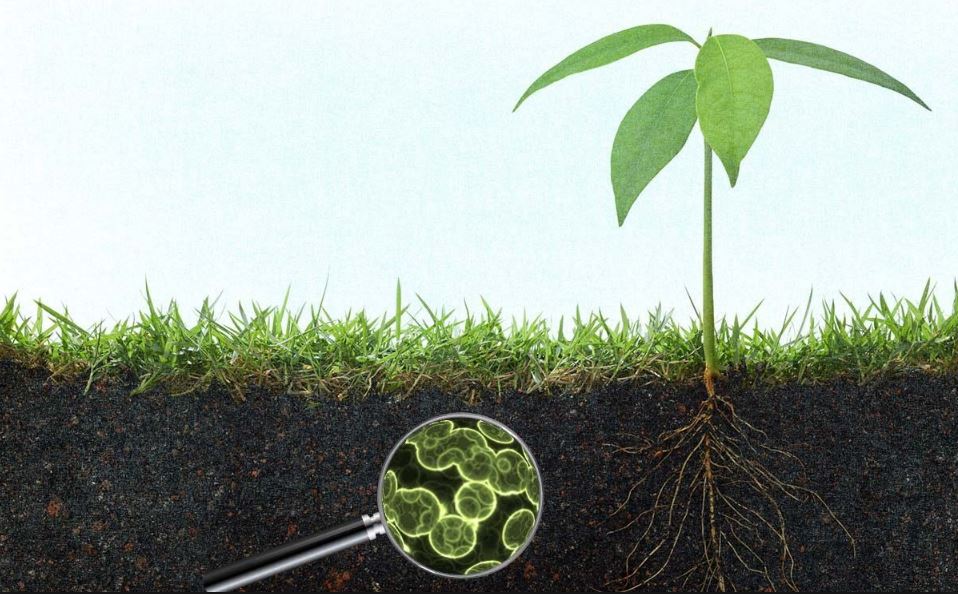 [pdf-embedder url=”https://treefresno.org/wp-content/uploads/2018/09/Indigo-Microbes-for-Big-Agriculture.pdf” title=”Indigo – Microbes for Big Agriculture”]
[pdf-embedder url=”https://treefresno.org/wp-content/uploads/2018/09/Indigo-Microbes-for-Big-Agriculture.pdf” title=”Indigo – Microbes for Big Agriculture”]
 [pdf-embedder url=”https://treefresno.org/wp-content/uploads/2018/09/Indigo-Microbes-for-Big-Agriculture.pdf” title=”Indigo – Microbes for Big Agriculture”]
[pdf-embedder url=”https://treefresno.org/wp-content/uploads/2018/09/Indigo-Microbes-for-Big-Agriculture.pdf” title=”Indigo – Microbes for Big Agriculture”]
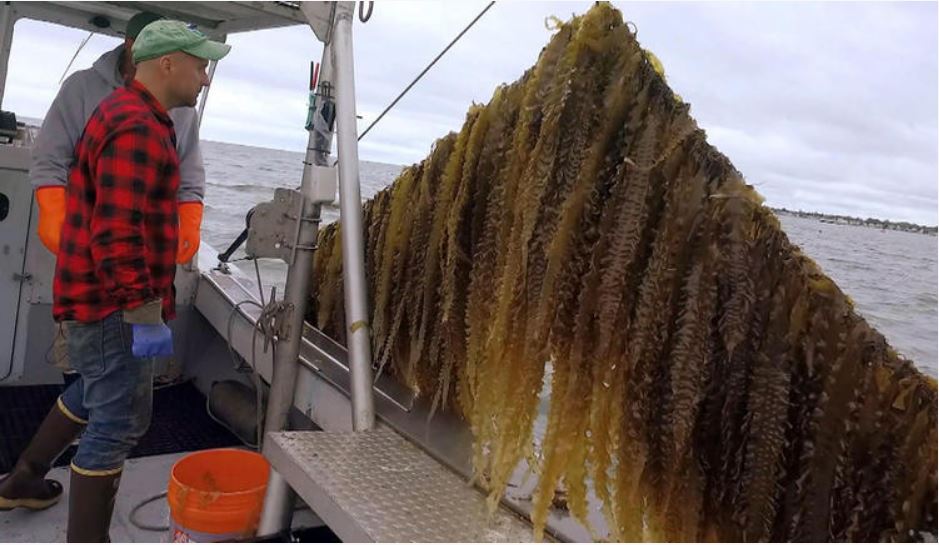
Seaweed may be thought of as a nuisance, but an increasing number of fishermen, scientists and consumers are seeing it as a solution
Many of us think of seaweed as a nuisance — the slimy, sometimes smelly stuff that clogs fishermen’s nets, gets tangled in our ankles in the ocean, and washes up unwanted on the beach. Even its name — sea-weed — implies something undesirable.
And yet increasing numbers of fishermen, scientists, and foodies in this country are starting to look at seaweed very differently — as a promising source of food, jobs and help cleaning ocean waters. With rising global populations and limited space to expand agriculture on land, they are turning to the sea — and its “weeds” — as a new frontier.

Bren Smith
Bren Smith: Welcome aboard.
Lesley Stahl: Thank you.
It’s not often you get a ride to visit a farm on a boat. But we were on-board with Bren Smith, the nation’s leading advocate for a whole new type of farming — ocean farming. We joined him on a cold day in December, the time of year he heads out to his version of fields to plant his staple crop, a type of seaweed called sugar kelp.
Bren Smith: Here it is.
Lesley Stahl: This is the farm? I can’t see anything. (LAUGH)
Bren Smith: The whole idea is it’s down under the water. So, see the white buoys?
Lesley Stahl: Yes.
Bren Smith: That’s the edges of the farm.
Lesley Stahl: And the black ones?
Bren Smith: Black buoys are holding up a horizontal rope below the surface. So it’s rows– kinda rows of crops. So this is the seed.
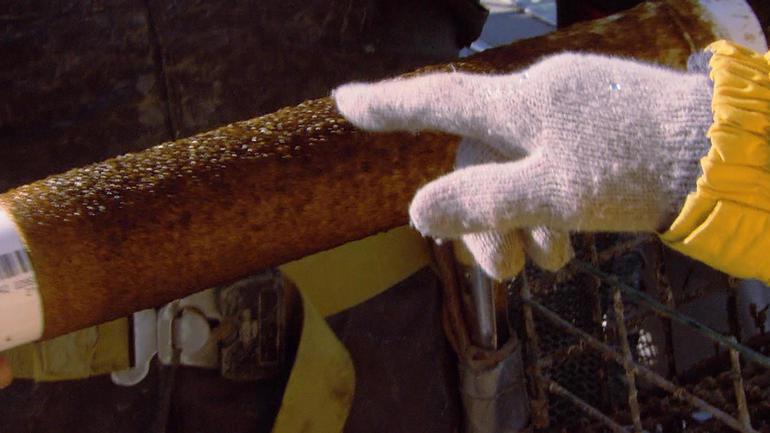
He showed us what looked like a tube covered in fuzz.
Lesley Stahl: Is that kelp?
Bren Smith: Yeah, these are the baby plants, they’re about two millimeters. And these are gonna– gonna grow to 15, 18 feet by the spring. It’s one of the fastest growing plants on earth.
And unlike all those plants that grow in earth, seaweed doesn’t need fertilizer, or freshwater. It’s what’s called a zero-input crop.
Bren Smith: So now we’re just gonna unravel it.
Just attach the string it grows on to rope and suspend it eight feet under water.
Lesley Stahl: And that’s it, huh?
Bren Smith: That’s it.
In five or six months, that fuzz will look like this. This was some of his crop last year. Smith began leasing the right to farm this 20-acre plot of water in 2012 from the state of Connecticut. His was the first commercial seaweed farm in the state. Now there are nine, with a half dozen more in the works.
Bren Smith: We hope you know, in 10, 20 years, there are thousands of farmers doing this. We think it’s the future, the time to move out in the ocean and luckily we can do it the right way.
Smith spent most of his life working the oceans in what he now considers the wrong way — on industrial fishing boats, going after lobster, tuna, and cod.
Bren Smith: We were tearing up whole ecosystems with our trawls, fishing in illegal waters,and just really chasing fewer and fewer fish further and further out to sea.
Lesley Stahl: And you didn’t think about–
Bren Smith: No.
Lesley Stahl: –the idea that you were depleting the population of fish?
Bren Smith: The oceans just seemed boundless.
Boundless, and bountiful.
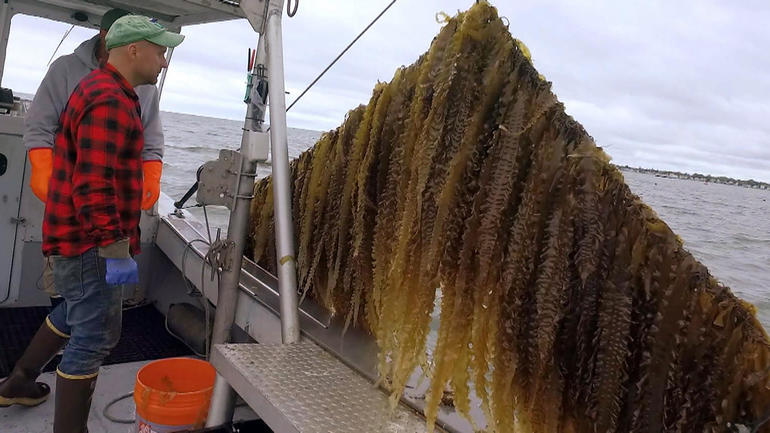
Bren Smith: The sense of meaning of helping feed my country — you know, fishermen– there’s some jobs, you know, coal– coal workers, farmers, I think steelworkers, and– and fishermen where, you know, they’re jobs that are soul-filling. You know, they’re jobs that we write, and sing songs about. And I just, I wanted that life. And it’s– I still do.
But that life was increasingly in peril. Cod stocks crashed due to overfishing, and after Smith reinvented himself cultivating oysters in Long Island Sound, Hurricanes Irene and Sandy hit, destroying his crop two years in a row.
Dr. Charlie Yarish: Bren was really on the verge of bankruptcy.
Searching for a new career on the water, he sought advice from Charlie Yarish, a professor of marine biology whose lab at the University of Connecticut studies some of the thousands of different types of seaweeds.
Dr. Charlie Yarish: But there’s only 20 globally that are actually farmed.
Lesley Stahl: They’re not all edible?
Dr. Charlie Yarish: No, they’re not all edible. Some of ’em actually are quite toxic.
It was Yarish who suggested Smith consider sugar kelp, a local seaweed that gets planted after hurricane season is over, has a mild taste, and can also be used as animal feed and fertilizer.
Lesley Stahl: Seaweed for you, was the lightbulb?
Bren Smith: Yeah, yeah.
Lesley Stahl: The eureka moment.
Bren Smith: We can create jobs here. We– we can protect and improve the environment. We don’t have to make this choice–
Smith now operates one of the largest seaweed hatcheries in the country, with tanks full of developing kelp spores, and a processing room that comes alive in spring when he and his team bring in the harvest and get it ready for sale. Blanched in 170-degree water, kelp turns a vivid green and can then be sold fresh or frozen, sometimes in the form of noodles. Smith’s customers include Google for their cafeteria, Yale University, and several restaurants and wholesalers. He has sold out the last four years.
But at this kelp farm across the country in the waters outside Seattle, producing food is almost beside the point. This is a test farm, where Betsy Peabody of the Puget Sound Restoration Fund and a team of scientists are doing an experiment to see whether seaweed can help fight the growing problem of ocean acidification — caused mainly by increasing carbon dioxide levels in the seas.
Betsy Peabody: Roughly 25% of CO2 in the atmosphere is being absorbed into oceans.
Lesley Stahl: And that is what we’re getting from fossil fuels?
Betsy Peabody: From both carbon emissions, from deforestation, and I think initially people thought, “Well, thank goodness the oceans are taking up some of that carbon dioxide.” But then, scientists started to document that, in fact, when that carbon dioxide goes into the ocean, it causes chemical changes.
Changes like increasing the water’s acidity, as documented in the U.S. government’s 2017 climate science special report. The excess CO2 causes “a decrease of carbonate ions… Which many marine species use to build their shells and skeletons.” Worldwide, “ocean surface waters have become 30% more acidic over the last 150 years.” And in the Pacific Northwest, the problem is compounded by currents that bring more carbon-rich waters to the surface. And that’s where seaweed comes in.
Dr. Charlie Yarish: Kelp take up carbon dioxide like any plant does, and it just so happens it lives in the water. There are winners and losers in ocean acidification. Organisms that produce carbonate shells like shellfish, they’re a loser. They can’t handle the lower PH. They can’t deposit as much calcium in their shells. On the other hand, when seaweeds like kelp, they actually pick up that carbon dioxide because now it’s easier for them to do photosynthesis.
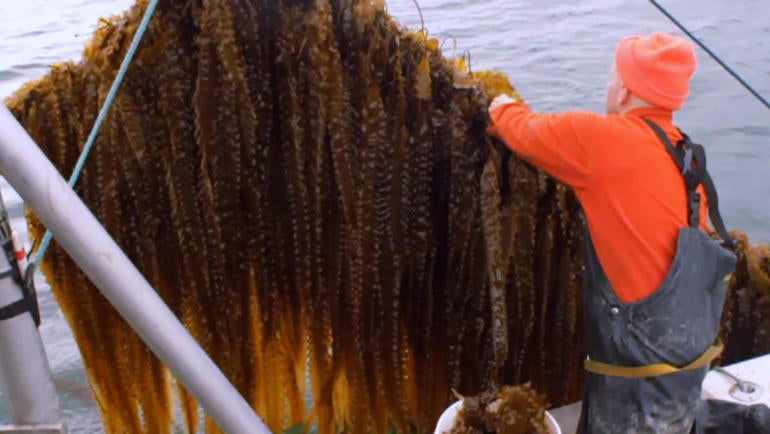
Betsy Peabody: Imagine trees on land, pulling CO2 out of the atmosphere. Well, seaweeds and kelp are really good at pulling CO2 out of the water.
Lesley Stahl: So basically what you’re doing is the equivalent of planting trees in the ocean?
Betsy Peabody: Exactly.
And then testing to see how much of a difference it makes.
Betsy Peabody: We’ve got scientific mooring buoys anchored at both sides.
Lesley Stahl: The yellow.
Betsy Peabody: The yellow buoys.
They’re measuring how water changes as it flows through the kelp field, and seeing if baby shellfish grown with the kelp do better at building their shells. Results won’t be in for more than a year, and Bren Smith is eager to see them. He’s been growing shellfish on his kelp farm too — but not, he admits, because of the science. He says, it’s good business. In November, he and his team loaded thousands of baby mussels into netting that looked like massive sausages, then suspended them from ropes that hang down below the kelp. He calls it 3D ocean farming.
Lesley Stahl: Why 3D?
Bren Smith: We call it that because we’re using the entire water column. And if you can stack crops on top of each other it’s just really efficient. You don’t use large, you know, plots of ocean. But you get so much food.
Lesley Stahl: So you’ve got your seaweed.
Bren Smith: Yup. You’ve got the kelp here. And then we have the mussels.
Underwater, each row looks something like this.
Bren Smith: Off those same lines we have scallops. And then below the whole system we have cages with oysters in them.
He brought up one of those oyster cages from the bottom to show us.
Lesley Stahl: What kind are these?
Bren Smith: We call these Thimble Island salts.
Bren Smith: Let’s haul some mussels.
And he hauled up a mussel line so we could see their progress too.
Lesley Stahl: They’re in bunches.
Bren Smith: These are about mid-size. So they’ll double in size and we’ll harvest these just about the same time we harvest our kelp. So this is gonna be a big harvest.
Lesley Stahl: So are you a fisherman, or are you a farmer?
Bren Smith: I’m a farmer now. Whether I like it or not (LAUGH) I’m an ocean farmer. And I talk to fishermen about this. I say, “Listen. We have to make this transition, that heartbreaking move from being a hunter to a farmer. But what else are the pieces of what it is– sorta to be a fisherman? It’s to own your own boat, succeed and fail on your own terms, and have the pride of feeding our country. We get to keep those things.
He’s so convinced, he’s launched a non-profit called Greenwave to encourage others to follow his lead. Husband and wife Jay Douglass and Suzie Flores are among his seaweed-farming disciples. A former marine who served in Afghanistan and Iraq, Douglass learned the ropes, literally, on Smith’s farm last spring, spent a year getting a permit for his own plot of ocean in Connecticut, and built 36 anchors from scratch. The day he and Flores went out to plant their first crop, Smith was along for guidance.
His non-profit provides free seed, and guarantees to buy 80% of their harvest for the first two years. He estimates that with a $10-thousand to $20-thousand investment and a boat, new farmers can turn a small profit the first year, rising to well over $100-thousand later on.
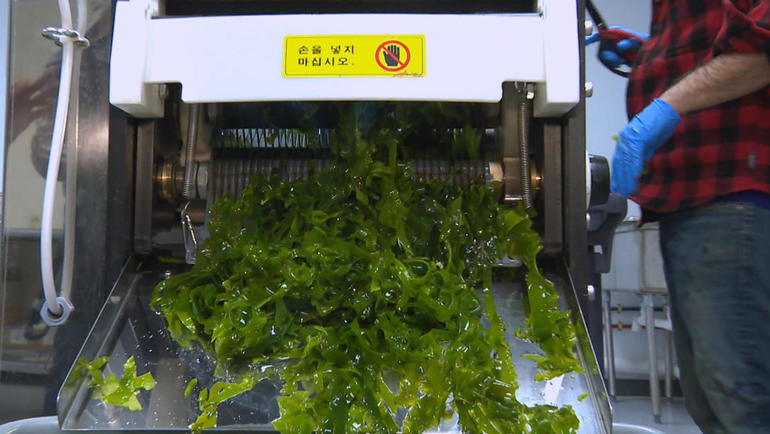
Lesley Stahl: Has anyone actually said, “You know, you guys are a little nuts”?
BOTH: Yeah.
Jay Douglass: People just– ya know, kinda scratch their heads and say, “What do– what are you makin’ all these anchors for?” And it’s just, like, “I’m startin’ a kelp farm,” you know. (LAUGH)
Lesley Stahl: “What the hell is kelp?”
Jay Douglass: Yeah, right. (LAUGHTER)
Suzie Flores: “Why?”
Jay Douglass: Yeah, “Why,” yeah. (LAUGHTER)
Which raises a question for this whole endeavor, will Americans in large numbers start eating seaweed?
Barton Seaver: Just toss some in there, a little kelp.
Chef and author Barton Seaver thinks so. He’s written a whole cookbook of seaweed recipes.
Lesley Stahl: When I hear the word “Seaweed,” the last thing in my head is, “I wanna eat that.” (LAUGH) You think they’ll buy it out there?
Barton Seaver: I do. (LAUGH) I think, you know, ten years ago, kale wasn’t on the shelf.
He says first off, the name “seaweed’s” gotta go. He prefers “sea greens.”
Lesley Stahl: So, is this one of the dishes you created?
Barton Seaver: This is an Italian dish that typically uses spinach.
He suggests integrating seaweed — pardon, sea greens — into things we already know and like.
Lesley Stahl: Are you nervous that I might not like it?
Barton Seaver: In front of all of America? No! Not at all.
Lesley Stahl: [laughs]
Surprisingly it didn’t taste fishy or seaweed-y. And he says kelp is rich in calcium, fiber, iron, and anti-oxidants.
Lesley Stahl: It’s really good. It is really good.
Bren Smith: I mean, this is what’s exciting about this space. The oceans are a blank slate. For my generation this is a really exciting moment– I can farm and grow food, but also I can soak up carbon and nitrogen while creating jobs, while giving people the opportunity to create small businesses.
And while fulfilling his dream of living his life on the water.
Bren Smith: Yeah. I wanna die on my boat one day. That’s sort of the goal. And I think if I look over my life, my goal is just always, “How do I keep working at sea?”
Produced by Shari Finkelstein. Associate producer, Jaime Woods.

Change in Urban/Community Tree Cover by State
Declining urban and community tree cover in the United States
 Newtown Square, PA, April 18, 2018 – Scientists with the USDA Forest Service estimate that between 2009 and 2014, tree cover in the Nation’s urban/community areas declined by 0.7 percent, which translates to losing an estimated 36 million trees or approximately 175,000 acres of tree cover annually. Pavement and other impervious cover increased at a rate of about 167,000 acres a year during the same period, according to research by USDA Forest Service scientists.
Newtown Square, PA, April 18, 2018 – Scientists with the USDA Forest Service estimate that between 2009 and 2014, tree cover in the Nation’s urban/community areas declined by 0.7 percent, which translates to losing an estimated 36 million trees or approximately 175,000 acres of tree cover annually. Pavement and other impervious cover increased at a rate of about 167,000 acres a year during the same period, according to research by USDA Forest Service scientists.
Nationally, urban/community tree cover declined from 42.9 percent to 42.2 percent. Twenty-three states had a statistically significant decrease in tree cover, with a total of 45 states showing a net decline. Trees improve air and water quality, reduce summer energy costs by cooling homes, reduce noise, mitigate runoff and flooding, and enhance human health and well-being, making them important to human health and urban and community infrastructure. The annual benefits derived from U.S. urban forests due to air pollution removal, carbon sequestration, and lowered building energy use and consequent altered power plant emissions are estimated at $18 billion.
The study by Dave Nowak and Eric Greenfield of the USDA Forest Service’s Northern Research Station, “Declining urban and community tree cover in the United States,” was published in the journal Urban Forestry and Urban Greening and is available at: https://www.nrs.fs.fed.us/pubs/55941
A table showing tree cover and impervious cover change by state is available at: https://www.nrs.fs.fed.us/news/release/resources/cities-communities-losing-tree-cover/
“Urban forests are a vital part of the nation’s landscape,” said Tony Ferguson, Director of the Forest Service’s Northern Research Station and the Forest Products Laboratory. “Forest Service research puts knowledge and tools into the hands of urban forest managers that supports stewardship and the wise allocation of resources.”
States or districts with the greatest annual net percent loss in urban/community tree cover were Rhode Island and the District of Columbia (minus 0.44 percent), Georgia (minus 0.40 percent), and Alabama and Nebraska (minus 0.32 percent each). States with the greatest annual net loss in tree cover were Georgia (minus 18,830 acre/year), Florida (minus 18,060 acre/year) and Alabama (minus 12,890 acre/year).
Three states – Mississippi, Montana and New Mexico – had slight, non-significant increases in urban/community tree cover. Nationally, Maine has the highest percent tree cover in urban/community areas with 68 percent tree cover. At 10 percent tree cover, North Dakota ranked as having the lowest percent urban/community tree cover.
“Urban forests are an important resource,” said Nowak. “Urban foresters, planners and decision-makers need to understand trends in urban forests so they can develop and maintain sufficient levels of tree cover – and the accompanying forest benefits – for current and future generations of citizens.”
As of 2010, urban land occupied 3 percent, or 68 million acres, of the United States, while urban/community land occupied just over 6 percent of the United States, or 141 million acres.
Overall, urban/community impervious cover had a statistically significant increase from 14.5 percent to 15.1 percent (an increase of 0.6 percent), States with the greatest annual net percent increase in impervious cover were Delaware (0.28 percent), Iowa (0.26 percent), and Colorado, Kansas and Ohio (0.24 percent each). States with the greatest annual net increase in impervious cover were Texas (17,590 acre/year), Florida (13,900 acre/year) and Ohio (8,670 acre/year).
###
The mission of the Northern Research Station is to improve people’s lives and help sustain the natural resources in the Northeast and Midwest through leading-edge science and effective information delivery.
###
The mission of the U.S. Forest Service, an agency of the U.S. Department of Agriculture, is to sustain the health, diversity and productivity of the nation’s forests and grasslands to meet the needs of present and future generations. The agency manages 193 million acres of public land, provides assistance to state and private landowners, and maintains world-renowned forestry research and wildland fire management organizations. National forests and grasslands contribute more than $30 billion to the American economy annually and support nearly 360,000 jobs. These lands also provide 30 percent of the nation’s surface drinking water to cities and rural communities; approximately 60 million Americans rely on drinking water that originated from the National Forest System.
###
USDA is an equal opportunity provider and employer. To file a complaint of discrimination, write to USDA, Assistant Secretary for Civil Rights, Office of the Assistant Secretary for Civil Rights, 1400 Independence Avenue, S.W., Stop 9410, Washington, DC 20250-9410, or call toll-free at (866) 632-9992 (English) or (800) 877-8339 (TDD) or (866) 377-8642 (English Federal-relay) or (800) 845-6136 (Spanish Federal-relay).
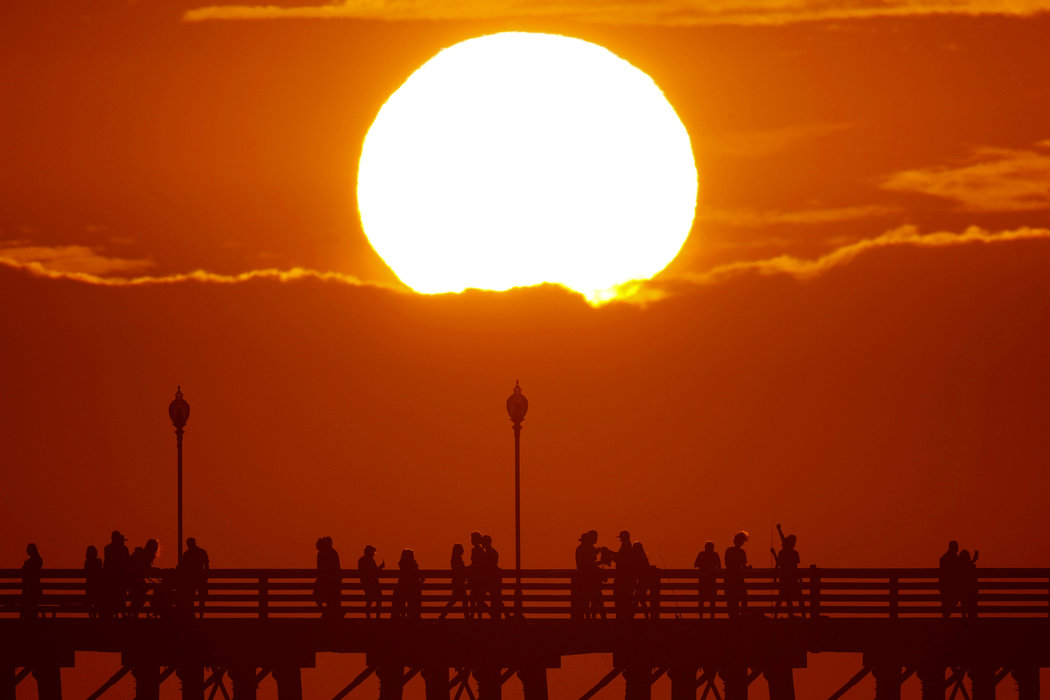
July kicked off with searingly hot temperatures for most Americans this year.
New daily, monthly and all-time record highs were set across the country last week, with more than 100 million people sweating it out under heat warnings or advisories. But the low nighttime temperatures that usually provide a crucial respite from scorching summer days have been more quietly making history.
On July 2, Burlington, Vt., set a record for its hottest overnight temperature as the thermometer refused to budge below 80 degrees Fahrenheit. Four days later, central Los Angeles hit 95 degrees before 11 a.m., already breaking the previous daily record of 94 degrees, before rising to well over 100 in the afternoon.
More of the U.S. is Seeing Extremely Warm Temperatures at Night
Percentage of the United States in which local areas are experiencing
extreme minimum (nighttime) and maximum (daytime) summer temperatures

50% of United States area
50%
Extremely warm
nighttime lows
Extremely warm
daytime highs
40%
40%
30%
30%
20%
20%
10%
10%
1920
1940
1960
1980
2000
1920
1940
1960
1980
2000
Nationwide, summer nights have warmed at nearly twice the rate of days, with overnight low temperatures increasing 1.4 degrees Fahrenheit per century since 1895, when national temperature records began, compared to a daytime high increase of 0.7 degrees per century. (Nights have warmed faster than days during other seasons, too.)
That pattern, which is in keeping with climate change models, is expected to continue as the world warms because of human-caused carbon emissions.
Derek S. Arndt, chief of the climate monitoring division at the National Oceanic and Atmospheric Administration, called the increase in summer nighttime temperatures a “dramatic example” of how small shifts in average temperature can lead to big consequences in the extremes.

In a typical year, heat waves kill more Americans than any other natural disaster including floods, tornadoes and hurricanes.
While warm summer nights may seem less concerning than scorching afternoons, “the combination of high daytime and high nighttime temperatures can be really lethal because the body doesn’t have a chance to cool down during the nighttime hours,” said Lara Cushing, professor of environmental epidemiology at San Francisco State University.
Those risks are higher in places where temperatures have historically been cooler, like coastal California. There people are less physiologically acclimated (the body can get used to higher temperatures up to a point) and less behaviorally adapted to hot weather.
“A hundred and five degrees in San Francisco is going to have a bigger impact probably than 105 degrees in Houston, Tex., where everybody has air conditioning and people are accustomed to dealing with high temperatures,” Dr. Cushing said.
Older people, the sick, and young children are especially at risk. So are agricultural, construction and other outdoor workers, who can no longer avoid the heat by shifting their hours to work earlier or later in the day. Similarly, homeless people who bear the full brunt of the elements get little relief.
In cities like Los Angeles, Asian-American, black, and Hispanic residents are more likely to live in hotter parts of the city than white residents because of a complicated range of factors like green spaces, elevation, prevailing winds and proximity to the ocean. Lack of green spaces in some neighborhoods, for example, can exacerbate the heat island effect, a phenomenon in which cities are as much as 22 degrees Fahrenheit warmer than less built-up environments because of of their impervious, heat-absorbing surfaces.
While air conditioning can provide a respite from intense heat, it isn’t a panacea. Air conditioners work by sending hot air outside, adding to the heat island effect. If fossil fuels are used to provide power for air conditioners, it exacerbates climate change. And, increased air conditioner use taxes electrical grids making power failures more likely. In the midst of the recent heatwave, roughly 90,000 Los Angeles area residents lost power because transformers, which help distribute electricity, overheated and failed.
Health officials in Canada estimated that up to 70 people in Quebec may have died from heat-related causes after last week’s heat wave stretched north.

The Suburban Golf Course, Reconsidered For The Age Of
Less than four years ago, the golf course at the center of Clear Lake City, Texas, looked like any other suburban golf course, with vast tracts of meticulously manicured lawns stretched across 178 acres of rolling hills. Golf courses are one of the least sustainable uses of urban green space, and like any of the thousands of golf courses scattered throughout the U.S.—which make up a whopping 45% of golf courses worldwide—Clear Lake City’s required an inordinate amount of water for maintenance and upkeep. But today, the golf course is something else entirely: a glimpse at the future of climate change resilience.
With an ongoing, five-phase project called Exploration Green, Clear Lake City has begun to transform the former country club into a network of engineered, flood-detention ponds designed to accommodate an estimated half billion gallons of stormwater. Each of the ponds, which will undergo fine grading and erosion control, will act as giant, slow-draining landing basins to harness water and mitigate flooding to immediate areas.
The new systems will greatly expand upon the city’s preexisting drainage ditches, which have long proved insufficient for the town’s explosion of development and growth in recent decades, and overwhelmed communities downstream during heavy rainfalls. Working to accommodate water rather than blockade it, Clear Lake City’s residents are embracing a strategy of learning to live with nature—a tactic that the Dutch have been known to practice to great success. When completed, the Clear Lake City Water Authority (CLCWA) will have essentially retrofitted the city’s existing landscape to withstand a 100-year storm event.
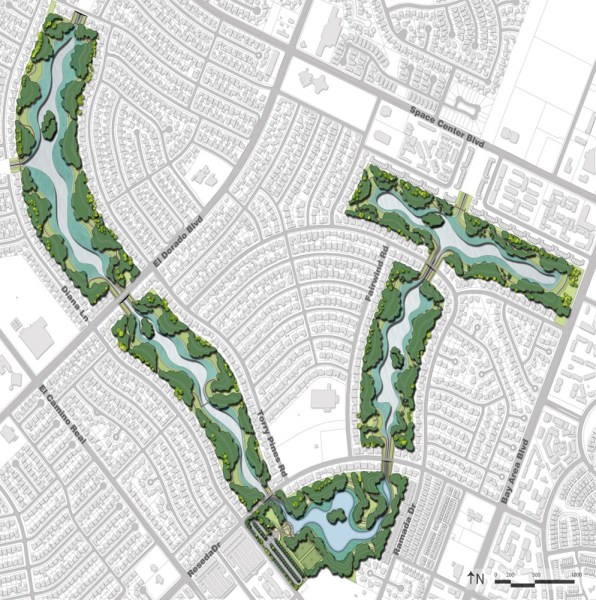
Last August, Hurricane Harvey swept through the region, dropping upwards of 60 inches of rainfall and causing an estimated $125 billion of damage. It was the second most destructive hurricane in the U.S. on record, after Katrina. Luckily for the citizens of Clear Lake City, Phase 1 of Exploration Green was nearing completion—and saved nearly 200 homes that would have otherwise flooded. After witnessing its success, the CLCWA took steps to aggressively fast-track its initial 15-year project timeline to just five years, with one 100,000-acre detention pond to be completed per year. When all five phases of Exploration Green are completed in 2022, the revamped green space is projected to protect more than 2,000 flood-prone homes from heavy rains and stormwater runoff.
Climate change is here. Cities need to adapt—and faster than they realize, with lean solutions that, like Exploration Green, make use of existing infrastructure. Here’s what Clear Lake City is doing to make resiliency a reality—and what other flood-prone cities could learn.
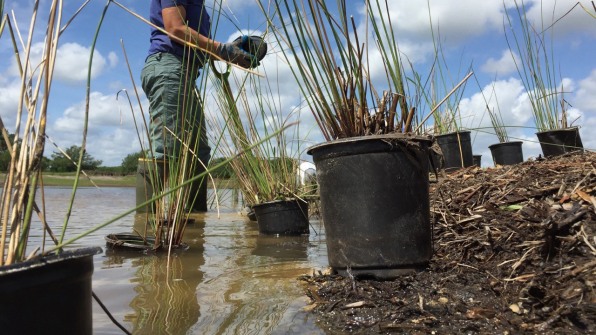
The long saga of reclaiming the golf course began in 2005, when its owner, Renaissance Golf Group LLC, looked to sell the land to residential and commercial developers for a hefty profit. Shuttered for nearly a decade after losing popularity over the years, the golf course had already become a de facto park for local residents.
Wary of recent overdevelopment and increasing flood risk in the community, the city’s residents approached the CLCWA to see what could be done. The water authority, in turn, hired two hydrologists to survey the property “to see how potential development would affect flooding,” says board president John Branch. After determining that paving the green space would significantly increase flooding, Branch, the water authority, and a team of community members began a battle to acquire the land and halt further development.
When the owners denied the CLCWA’s offer to purchase the golf course, they had the land publicly condemned and took it to court, in a case that motioned through the local court system, and up to the appellate circuit. “An appeal would have gone up to the State Supreme Court,” says Branch, “at which point the seller decided he’d rather cut his losses and go ahead and sell it to us.”
In 2011, the CLCWA successfully acquired the land for $6.2 million—significantly below its real estate appraisal that reached as high as $15 million. Through a series of Town Hall meetings that followed, the idea for Exploration Green was born. The water authority hired Houston-based landscape architecture and urban design firm SWA Group—which has worked on local projects including Buffalo Bayou and Hermann Park—to create a master plan for a newly converted green space encompassing permanent water storage, as well as wetlands, and native habitats that will serve as a year-round park for residents.
As Branch attests, forming the idea for Exploration Green and getting it off the ground would not have been possible without enthusiastic involvement from the community—many whom are longtime employees, colleagues, and contractors of the nearby NASA Johnson Space Center (which opened in 1973), and the various aerospace engineering, biochemical, and petrochemical industries also stationed in proximity. “I’m a former Shell employee and can bring in some engineering tech knowledge from a different industry,” says Branch, “but most everyone else on the board are NASA employees or contractors.”
While not all residents have rallied behind the effort (a small number of them convened in 2013 to form the organization Friends of the Old Golf Course, in opposition), it has largely been supported by a majority consensus through the Town Hall meetings. Exploration Green, Branch explains, is named to nod to the community’s collective ties to pioneering science efforts, as well as to Houston’s urban park, Discovery Green.
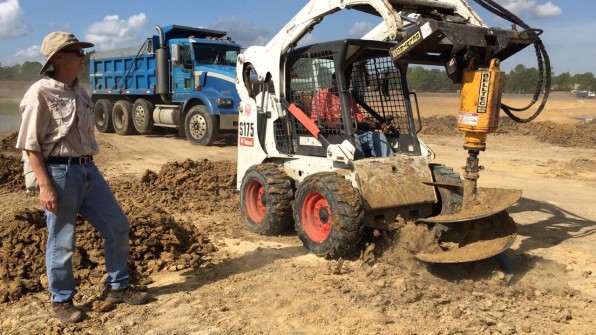
When Clear Lake City—a master-planned, residential community on the south-eastern edge of Houston, and the first of its kind to be built in Texas—was first developed in 1963, its design placed a golf course at the center of the community. Five decades on, the centralized green space, which snakes throughout the community, has proved to be a unique boon to Exploration Green. Crucially, because the community was also developed before there were any existing water, sewage, or drainage facilities in place, Clear Lake City—and its water systems, administered under CLCWA—holds infrastructural autonomy from the city of Houston.
This proved beneficial for the CLCWA, which was able to more nimbly begin construction efforts, notes Kelly Shipley, an associate project manager of Lockwood, Andrews, & Newnam Inc., the firm that is design engineering the project and overseeing construction. “The area was built before detention requirements existed, so there was nothing there,” says Branch. “But because [the golf course] was open green space,” she adds, “it had absorbed a lot of the rainwater,” making it an ideal site for detention ponds.
“The goal of Harris County’s Flood Control is to get water off the streets and out of the area—so their existing drainage channels are made to do that,” Shipley explains. “What Clear Lake is doing is converting those channels into city detention ponds, which, instead of turning the water out, will slow it down, and allow more time for the water to get back out into the bayous and the Gulf. It’s retaining water, and providing a place for that water to go and prevent it from flooding people downstream.”
Engineering each of the detention ponds will require a huge excavation effort, and the team estimates the removal of more than 200,000 dump trucks of soil over the course of the project, a logistical demand that played a large factor in determining feasibility for an expedited completion schedule. The nearly 340,00 cubic yards of soil that have been excavated thus far for Phase 1, Branch said, has been sold to a nearby development to use as fill.
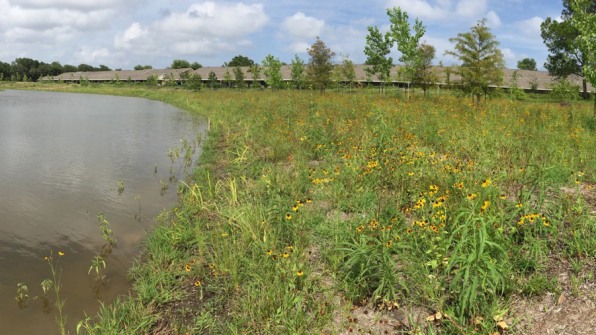
The strategy of building to accommodate storm runoff, rather than blockade or banish it, is core to Exploration Green—and as part of that, the community has also taken steps to ensure the place can double as a park for the vast majority of the year when it’s not storm season.
“We kind of looked around and said, ‘Hey, we don’t want it to just be a big hole in the ground with a fence around,’” says Branch. “We wanted it to be something special and kind of the same flavor of a green open space that could be used by the community.”
To that point, each of the detention ponds will maintain an amount of water year-round to create the feeling of a natural lake, surrounded by six miles of recreational hiking and bicycling trails. While the CLCWA will continue to administer the construction and maintenance of Exploration Green, the Explorer Green Conservancy—a non-profit entity formed by residents and volunteers—will spearhead fundraising and restoration efforts to bring native wildlife, wetland grasses, and trees to the site. Aside from beautifying the space for day-to-day use, the plantings will also help naturally treat contaminated stormwater before it’s released into the drainage systems and bayous.
Alliances and partnerships with other organizations have followed. Trees for Houston is donating 1,000 young trees for each phase of the project, and the Texas Coastal Watershed Program have provided a grant that will be used to create a wetlands nursery. “We’re also working with the Houston-Galveston Area Council to connect our hike and bike trails to existing trails throughout the county,” Branch says.
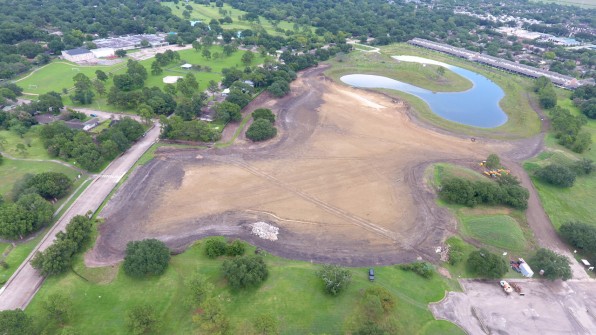
Hurricane Harvey was an important test, and Phase 1 of Exploration Green passed–even as it was under construction.
That empowered the CLCWA to open-source its design on the Exploration Green website, with the hopes that others would be able to benefit from their research. Other flood-prone communities in the Greater Houston region, including Inwood Forest, which was hard hit by Harvey, have already reached out to learn from their model, says Branch, as have various communities from other regions of the country, including Michigan and Virginia.
In a recent study conducted by the University of Houston’s Hobby School of Public Affairs, a majority of more than 2,000 residents polled primarily from Harris County voiced support for tighter building code restrictions and increased infrastructure projects to control flooding. Yet that same group also voiced significant opposition to funding those building measures through a tax hike—emphasizing a problematic divide between reaching a popular consensus, and having the means and agency to address it.
As Branch points out, many of Houston’s golf courses were flooded when Harvey hit the region last August—making Exploration Green an especially relevant case study. While a unique set of advantageous circumstances enabled the residents of Clear Lake City to take direct action on a swift timeline, he believes communities everywhere should feel empowered to engage and bring about direct change in their hometowns.
“We were a government entity, the people here supported us, they wanted something done, and there are a lot of ways to build it,” he added. “But you just can’t sit around waiting for someone else to do something.”
 [pdf-embedder url=”https://treefresno.org/wp-content/uploads/2018/05/Karlick-2012.pdf” title=”Karlick 2012″]
[pdf-embedder url=”https://treefresno.org/wp-content/uploads/2018/05/Karlick-2012.pdf” title=”Karlick 2012″]